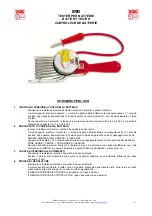
890
TESTER PER BATTERIE
BATTERY TESTER
CONTROLEUR DE BATTERIE
SWK Utensilerie S.r.l. Via Volta 3; 21020 Monvalle (VA) – Italy
Tel +39/0332/790111 Fax +39/0332/790602 Internet: www.usag.it E-mail:
2/2
INSTRUCTION FOR USE
1. CHECKING THE VOLTAGE, BATTERY NOT LOADED
-
Disconnect load resistors by unscrewing the knob.
-
With dead engine, press the point (
-
) on the negative pole of the battery and the red handle (
+
) on the
positive pole, after having checked that the poles are clean and without incrustations so to ensure a good
contact.
-
With 3 cell accumulators, the voltage under no load must be inclused between 5,5 and 6,5 Volt. With 6 cell
accumulators it must be between 11,5 and 12,5 Volt.
2. TEST OF CHARGING CONDITIONS
-
Connect the load resistors b y screwing the knob.
-
With dead engine, press the point (
-
) on the negative pole of the battery and the red handle (
+
) on the
positive pole, after having checked that the poles are clean so to ensure a good current passage.
THE TEST MUST NOT EXCEED 5 SECONDS.
-
Read carefully on the 6 or 12 Volt scale the voltage drop and consequently the charging state of the
battery: GREEN AREA = CHARGED / RED AREA = DISCHARGED
-
When the battery is the discharged, charge it again and repeat the test. If the battery is no yet enough
charged, this is because one or more cells are defective: they can be located because they begin to boil
during the test.
3. VOLTEG DROP WHEN STARTING
-
Disconnect the resistance by unscrewing the knob.
-
Start the engine, at the starting point the voltage drop of a well charged battery should not exceed 3 Volt.
4. REGULATOR
TEST
-
Disconnect the resistance by unscrewing the knob.
-
With started engine, press half the accelerator. The needle of the dial must be in the green area with yellow
part of the right side of the dial. On the contrary it means that:
THE REGULATOR CHARGES TOO MUCH (Needle on the red area on the right)
THE REGULATOR DOESN’T CHARGE ENOUGH (Needle on the red area on the left)
NOTICES D’EMPLOI
1. CONTROLE TENSION A VIDE DE LA BATTERIE
-
Débrancher la résistance de charge du testeur en dévissant le pommeau.
-
Le motour éteint, appuyer la pointe (
-
) sur le pole negatif et la poignée rouge (
+
) sur le pole positif,
après avoir controlé que les poles soient nettoyés et sans dépots, afin de permettre un bon contact.
-
En cas d’accumulateurs à 3 élements, la tension à vide doit etre comprise entre 5,5 et 6,5 Volt. Pour ceux
à 6 éléments doit etre entre 11,5 et 12,5 Volt.
2. ESSAI DE L’ETAT DE CHARGE DE LA BATTERIE
-
Brancher la résistance en vissant le pommeau.
Le motour éteint, appuyer la pointe (
-
) sur le pole negatif de la batterie et la poignée rouge (
+
) sur le
pole positif, après avoir controlé que les poles soient nettoyés de façon a assurer un bon pasage de
courant.
DUREE MAXIMALE DE L’ESSAI = 5 SECONDS.
-
Lire sur l’echelle 6 uo 12 Volt la chute de tension et par consequent l’état de charge de la batterie:
PLAGE VERTE = CHARGEE / PLAGE ROUGE = DECHARGEE
-
Si la batterie est déchargée, il faut la recharger et faire à nouveau l’essai. Si la charge est encore
insuffisante, ça signifie que l’un ou plus des éléments sont défectueux : on peut les individuer car ils
entrent en ébullition pendant l’essai.
3. CHUTE DE TENSION AU DEMARRAGE
-
Débrancher la résistance en dévissant le pommeau.
-
Démarrer le moteur; au démarrage la chute de tension sur une batterie suffisamment chargée ne doit pas
dépasser les 3 Volts.
4. ESSAI DU REGULATEUR
-
Débrancher la résistance en dévissant le pommeau.
-
Le moteur demarré, accelérer à demi-course. L’auguille de l’instruments doit se placer dans le plage verte
sur fond jaune sur la droite de l’instruments. Au càs contraire, ça signifie que:
LE REGULATEUR CHARGE TROP (Auguille dans la plage rouge à droite)
LE REGULATEUR NE CHARGE PAS SUFFISAMMENT (Auguille dans la plage rouge à gauche)
Y80
22
4
2
– 2
4
/0
9
/2
0
0
7


